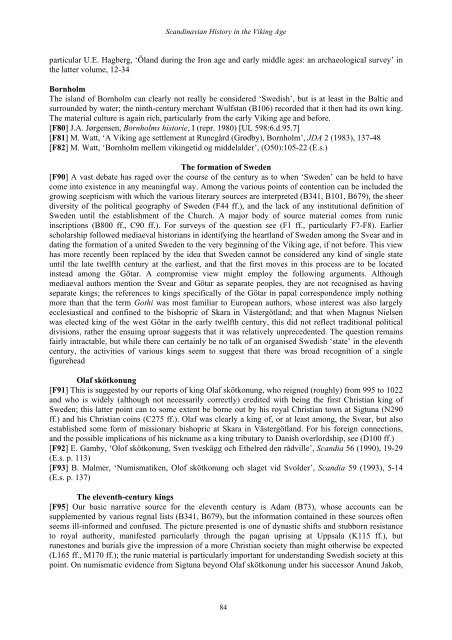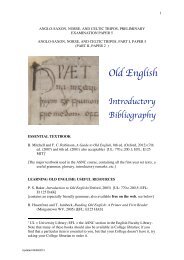Scandinavian history in the Viking age - Department of Anglo-Saxon ...
Scandinavian history in the Viking age - Department of Anglo-Saxon ...
Scandinavian history in the Viking age - Department of Anglo-Saxon ...
Create successful ePaper yourself
Turn your PDF publications into a flip-book with our unique Google optimized e-Paper software.
<strong>Scand<strong>in</strong>avian</strong> History <strong>in</strong> <strong>the</strong> Vik<strong>in</strong>g Age<br />
particular U.E. Hagberg, ‘Öland dur<strong>in</strong>g <strong>the</strong> Iron <strong>age</strong> and early middle <strong>age</strong>s: an archaeological survey’ <strong>in</strong><br />
<strong>the</strong> latter volume, 12-34<br />
Bornholm<br />
The island <strong>of</strong> Bornholm can clearly not really be considered ‘Swedish’, but is at least <strong>in</strong> <strong>the</strong> Baltic and<br />
surrounded by water; <strong>the</strong> n<strong>in</strong>th-century merchant Wulfstan (B106) recorded that it <strong>the</strong>n had its own k<strong>in</strong>g.<br />
The material culture is aga<strong>in</strong> rich, particularly from <strong>the</strong> early Vik<strong>in</strong>g <strong>age</strong> and before.<br />
[F80] J.A. Jørgensen, Bornholms historie, I (repr. 1980) [UL 598:6.d.95.7]<br />
[F81] M. Watt, ‘A Vik<strong>in</strong>g <strong>age</strong> settlement at Runegård (Grødby), Bornholm’, JDA 2 (1983), 137-48<br />
[F82] M. Watt, ‘Bornholm mellem vik<strong>in</strong>getid og middelalder’, (O50):105-22 (E.s.)<br />
The formation <strong>of</strong> Sweden<br />
[F90] A vast debate has r<strong>age</strong>d over <strong>the</strong> course <strong>of</strong> <strong>the</strong> century as to when ‘Sweden’ can be held to have<br />
come <strong>in</strong>to existence <strong>in</strong> any mean<strong>in</strong>gful way. Among <strong>the</strong> various po<strong>in</strong>ts <strong>of</strong> contention can be <strong>in</strong>cluded <strong>the</strong><br />
grow<strong>in</strong>g scepticism with which <strong>the</strong> various literary sources are <strong>in</strong>terpreted (B341, B101, B679), <strong>the</strong> sheer<br />
diversity <strong>of</strong> <strong>the</strong> political geography <strong>of</strong> Sweden (F44 ff.), and <strong>the</strong> lack <strong>of</strong> any <strong>in</strong>stitutional def<strong>in</strong>ition <strong>of</strong><br />
Sweden until <strong>the</strong> establishment <strong>of</strong> <strong>the</strong> Church. A major body <strong>of</strong> source material comes from runic<br />
<strong>in</strong>scriptions (B800 ff., C90 ff.). For surveys <strong>of</strong> <strong>the</strong> question see (F1 ff., particularly F7-F8). Earlier<br />
scholarship followed mediaeval historians <strong>in</strong> identify<strong>in</strong>g <strong>the</strong> heartland <strong>of</strong> Sweden among <strong>the</strong> Svear and <strong>in</strong><br />
dat<strong>in</strong>g <strong>the</strong> formation <strong>of</strong> a united Sweden to <strong>the</strong> very beg<strong>in</strong>n<strong>in</strong>g <strong>of</strong> <strong>the</strong> Vik<strong>in</strong>g <strong>age</strong>, if not before. This view<br />
has more recently been replaced by <strong>the</strong> idea that Sweden cannot be considered any k<strong>in</strong>d <strong>of</strong> s<strong>in</strong>gle state<br />
until <strong>the</strong> late twelfth century at <strong>the</strong> earliest, and that <strong>the</strong> first moves <strong>in</strong> this process are to be located<br />
<strong>in</strong>stead among <strong>the</strong> Götar. A compromise view might employ <strong>the</strong> follow<strong>in</strong>g arguments. Although<br />
mediaeval authors mention <strong>the</strong> Svear and Götar as separate peoples, <strong>the</strong>y are not recognised as hav<strong>in</strong>g<br />
separate k<strong>in</strong>gs; <strong>the</strong> references to k<strong>in</strong>gs specifically <strong>of</strong> <strong>the</strong> Götar <strong>in</strong> papal correspondence imply noth<strong>in</strong>g<br />
more than that <strong>the</strong> term Gothi was most familiar to European authors, whose <strong>in</strong>terest was also largely<br />
ecclesiastical and conf<strong>in</strong>ed to <strong>the</strong> bishopric <strong>of</strong> Skara <strong>in</strong> Västergötland; and that when Magnus Nielsen<br />
was elected k<strong>in</strong>g <strong>of</strong> <strong>the</strong> west Götar <strong>in</strong> <strong>the</strong> early twelfth century, this did not reflect traditional political<br />
divisions, ra<strong>the</strong>r <strong>the</strong> ensu<strong>in</strong>g uproar suggests that it was relatively unprecedented. The question rema<strong>in</strong>s<br />
fairly <strong>in</strong>tractable, but while <strong>the</strong>re can certa<strong>in</strong>ly be no talk <strong>of</strong> an organised Swedish ‘state’ <strong>in</strong> <strong>the</strong> eleventh<br />
century, <strong>the</strong> activities <strong>of</strong> various k<strong>in</strong>gs seem to suggest that <strong>the</strong>re was broad recognition <strong>of</strong> a s<strong>in</strong>gle<br />
figurehead<br />
Olaf skötkonung<br />
[F91] This is suggested by our reports <strong>of</strong> k<strong>in</strong>g Olaf skötkonung, who reigned (roughly) from 995 to 1022<br />
and who is widely (although not necessarily correctly) credited with be<strong>in</strong>g <strong>the</strong> first Christian k<strong>in</strong>g <strong>of</strong><br />
Sweden; this latter po<strong>in</strong>t can to some extent be borne out by his royal Christian town at Sigtuna (N290<br />
ff.) and his Christian co<strong>in</strong>s (C275 ff.). Olaf was clearly a k<strong>in</strong>g <strong>of</strong>, or at least among, <strong>the</strong> Svear, but also<br />
established some form <strong>of</strong> missionary bishopric at Skara <strong>in</strong> Västergötland. For his foreign connections,<br />
and <strong>the</strong> possible implications <strong>of</strong> his nickname as a k<strong>in</strong>g tributary to Danish overlordship, see (D100 ff.)<br />
[F92] E. Gamby, ‘Ol<strong>of</strong> skötkonung, Sven tveskägg och E<strong>the</strong>lred den rådville’, Scandia 56 (1990), 19-29<br />
(E.s. p. 113)<br />
[F93] B. Malmer, ‘Numismatiken, Ol<strong>of</strong> skötkonung och sl<strong>age</strong>t vid Svolder’, Scandia 59 (1993), 5-14<br />
(E.s. p. 137)<br />
The eleventh-century k<strong>in</strong>gs<br />
[F95] Our basic narrative source for <strong>the</strong> eleventh century is Adam (B73), whose accounts can be<br />
supplemented by various regnal lists (B341, B679), but <strong>the</strong> <strong>in</strong>formation conta<strong>in</strong>ed <strong>in</strong> <strong>the</strong>se sources <strong>of</strong>ten<br />
seems ill-<strong>in</strong>formed and confused. The picture presented is one <strong>of</strong> dynastic shifts and stubborn resistance<br />
to royal authority, manifested particularly through <strong>the</strong> pagan upris<strong>in</strong>g at Uppsala (K115 ff.), but<br />
runestones and burials give <strong>the</strong> impression <strong>of</strong> a more Christian society than might o<strong>the</strong>rwise be expected<br />
(L165 ff., M170 ff.); <strong>the</strong> runic material is particularly important for understand<strong>in</strong>g Swedish society at this<br />
po<strong>in</strong>t. On numismatic evidence from Sigtuna beyond Olaf skötkonung under his successor Anund Jakob,<br />
84






